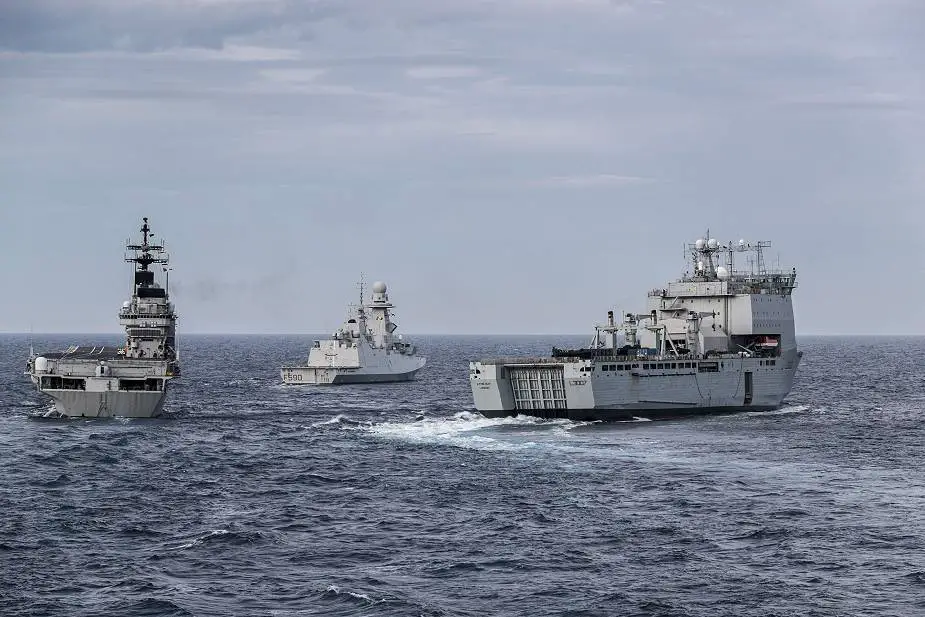According to information published by the British Royal Navy on November 30, 2020, the British Navy flagship HMS Albion amphibious transport dock and supporting amphibious ship RFA Lyme Bay conduct naval training with the Italian Navy ITS Giuseppe Garibaldi aircraft carrier and her escorts in the central Mediterranean.
Follow Navy Recognition on Google News at this link
 The Italian Navy aircraft carrier ITS Giuseppe Garibaldi, frigate ITS Carlo Bergamini and British Royal Navy RFA Lyme Bay maneuver in close formation. (Picture source British Royal Navy)
The Italian Navy aircraft carrier ITS Giuseppe Garibaldi, frigate ITS Carlo Bergamini and British Royal Navy RFA Lyme Bay maneuver in close formation. (Picture source British Royal Navy)
The HMS Albion amphibious transport dock and RFA Lyme Bay Bay-class auxiliary landing ship dock have formed the core of the UK’s Littoral Response Group which has spent the autumn conducting trials and exercises to help shape the amphibious forces and Royal Marines of the future.
The HMS Albion (L14) is an amphibious transport dock of the Royal Navy, the first of the two-ship Albion class. Built by BAE Systems Marine in Barrow-in-Furness. The class consists of two vessels, HMS Albion and HMS Bulwark, ordered in 1996 to replace the aging Fearless class. Albion was commissioned in 2003 and Bulwark in 2004.
The Albion-class LPDs have a length of 176 meters (577 ft), a breadth of 28.9 meters (95 ft), and a draught of 7.1 meters (23 ft). They have a normal displacement of 14,000 tonnes (14,000 long tons; 15,000 short tons), 19,560 tonnes (19,250 long tons; 21,560 short tons) at full load and 21,000 tonnes (21,000 long tons; 23,000 short tons) when the dock is flooded. The ships have a crew of 325 and can accommodate up to 405 troops, including their vehicles and combat supplies, in overload conditions.
The RFA Lyme Bay is a Bay-class auxiliary landing ship dock (LSD(A)) of the British Royal Fleet Auxiliary (RFA). Ordered from Swan Hunter in 2000, the ship was launched in 2005. The ship is capable of carrying up to 24 Challenger 2 tanks or 150 light trucks in 1,150 linear meters of space. The cargo capacity is equivalent of 200 tons of ammunition, or 24 Twenty-foot equivalent unit containers.
After participation in NATO’s Mediterranean maritime security mission, Operation Sea Guardian, the British ships began the long journey home to the UK – which brought them into contact with the Italian Navy for some combined training.
The ITS Garibaldi aircraft carrier is home to AV-8B jump jets (the US-built version of the Harrier) which tested their ability to evade the British defenses during an air defense exercise.
The Giuseppe Garibaldi is an aircraft carrier, the first through deck aviation ship ever built for the Italian Navy, and the first Italian ship built to operate fixed-wing aircraft. She is equipped with short take-off and vertical landing aircraft (STOVL) aircraft and helicopters. The ship is able to carry up to 18 fixed and rotary wings including AV-8B Harrier II fighter/bombers, Augusta SH-3D Sea King, or AgustaWestland AW101 helicopters.
The carrier group – completed by frigate ITS Carlo Bergamini and tanker Stromboli – conducted combined training with Albion and Lyme Bay, from basic communications through to maneuvering in close proximity, some helicopter ‘cross-decking’ and an anti-submarine exercise, before a ceremonial sail past prior as the two allies went their separate ways.
For the first time, the Garibaldi hosted a Wildcat helicopter as 847 Naval Air Squadron touched down on the carrier’s 571ft-long deck.



